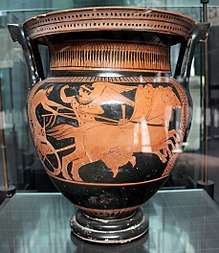Rudiae
Rudiae (Rusce ['Ruʃe] in the local dialect and Ῥοδίαι in ancient Greek), is presently an archaeological park beside the Via San Pietro in Lama that runs south-west from the city of Lecce. The place was identified as the former home of the poet Ennius by the Renaissance Humanist, Antonio de Ferraris.[1]
History

The ancient site of the city was first settled from the late ninth or early eighth centuries BCE by the Messapians. In the late sixth century BCE it developed in importance and, even after it had been partially Hellenised during the period of Magna Graecia, it still retained its native traditions.[2] According to Aulus Gellius, the poet Ennius referred to the linguistic and cultural heritage given him by the city in asserting that he had "three hearts", Greek, Oscan and Latin (Quintus Ennius tria corda habere sese dicebat, quod loqui Graece et Osce et Latine sciret).[3]
Rudiae is identified with the archaeological remains found in the immediate outskirts of Lecce. These comprise traces of an amphitheatre, a necropolis and two city walls built of tuff. In the past the walls were towered and defended by a ditch 4 km long.[4] Judging by the extent of these, its entire area covered some 100 hectares, twice the size of nearby Lupiae (as Lecce was then called) in the Roman period. Later the city lost importance and by the first century CE, according to Silius Italicus, was reduced to a modest village even as its neighbour was growing in size and importance.
From the archaeological standpoint, however, Rudiae seems to have played the role of stylistic and distribution centre for funerary pottery over a considerable period. It is recognised as the most important site for both quantity and quality of such vases used in the Messapian region.[5] Almost all local discoveries are housed in the Sigismondo Castromediano Museum in Lecce.[6]
References
Part of the article is translated from the Italian Wikipedia
- Pietro Napoli-Signorelli, Vicende della coltura nelle due Siclie dalla venuta delle colonie straniere sino a nostri giorni, 2nd edition, Naples 1810, vol.1, pp.406-7 and ff
- Young Sellar, William, The Roman Poets of the Republic, Cambridge University Press, 2011, ISBN 978-1-108-02982-7, p. 64
- Noctes Atticae 17.17.1
- Rudiae in The Princeton Encyclopedia of Classical Sites, Princeton University 1976
- Maria Teresa Giannotta, “Apulian Pottery in Messapian Contexts”, in The Italic People of Ancient Apulia: New Evidence from Pottery for Workshops, Markets, and Customs, Cambridge University 2014, p.200-2005
- Online images
External links
- Gianni Carluccio, Rudiae, patria del Poeta latino Quinto Ennio
- Rudiae – Fondo Anfiteatro